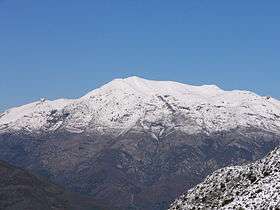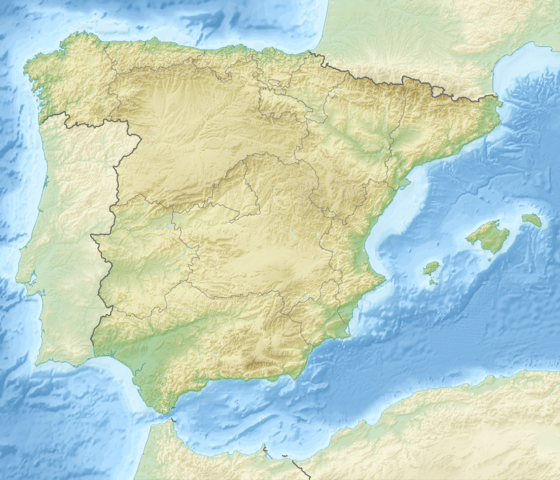Sierra de las Nieves
| Sierra de las Nieves | |
|---|---|
 Torrecilla Peak in the Sierra de las Nieves | |
| Highest point | |
| Peak | Torrecilla |
| Elevation | 1,919 m (6,296 ft) |
| Coordinates | 36°41′0″N 05°0′0″W / 36.68333°N 5.00000°WCoordinates: 36°41′0″N 05°0′0″W / 36.68333°N 5.00000°W |
| Geography | |
 Sierra de las Nieves Location in Spain | |
| Location | Málaga Province, Andalusia |
| Country | Spain |
| Parent range | Penibaetic System |
| Geology | |
| Orogeny | Alpine orogeny |
| Type of rock | Limestone |
Sierra de las Nieves is a mountain range of the Penibaetic System in Málaga Province, Andalusia, Spain. Its highest point is the 1,919 m high La Torrecilla peak. Enamorados (1,775 m) is another notable peak.
The Sierra de las Nieves is named after the snow that sometimes covers its heights in the winter and that used to be gathered in ice pits for local use.
Geography
This mountain range is part of the Serranía de Ronda ranges, located near Ronda inland from the Costa del Sol, to the east of the road to Ronda from Marbella.[1] The easiest route to reach it is from Ronda town.
The Sierra de las Nieves is a karstic range with some impressive shafts and caves. It is composed of a few subranges such as the Sierra de la Nieve, Sierra del Pinar and Sierra de Tolox. Rivers Guadalevín, which is well known for having cut the deep Tajo de Ronda canyon, El Burgo River, Alfaguara River, flowing through Tolox, the Río Grande, a tributary of the Guadalhorce, and for the Río Verde whose dam near Istán provides water to the Costa del Sol, have their sources in this range.[2]
Part of the area of the Sierra de las Nieves is a protected area since 1989 as the Sierra de las Nieves Natural Park located in the heart of the range and a biosphere reserve since 1995.[3]
Biodiversity
The park possesses a huge natural wealth, with really different fauna and flora. Some plant here are endemic, like the Spanish Fir (Abies pinsapo) or the Gall Oak. Other animal species such as the ibex or the otter maintain in this reserve populations of stable individual species. There is one Spanish Fir, the Pinsapo de Las Escaleretas, which has been declared a natural monument. The park also has a chestnut 800 or 1000 years old, the Castaño Santo.
See also
References
External links
- Comprehensive tourist information about Ronda in English
 Media related to Sierra de las Nieves at Wikimedia Commons
Media related to Sierra de las Nieves at Wikimedia Commons- 3D Virtual Tour of Sierra de las Nieves, 20/02/2011
- Awarded "EDEN - European Destinations of Excellence" non traditional tourist destination 2008